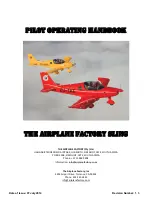
L A N D I N G W I T H A H E L P E
R
S E L F L A N D I N G ( L I G H T W I N D S )
S E L F L A N D I N G ( S T R O N G W I N D S )
P A C K I N G U P
First check if the area is clear of
people. Fly the kite to the ground at
the edge of the wind window. Here a
helper grabs the kite while you walk
forward.
First check if the area is clear of
people. Fly the kite to the ground at
the edge of the wind window. Grab
backwards towards the ground.
Secure it with some sand or other
suitable weight. Especially in strong
winds, a kite can easily take again,
and there is no tension on the flying
lines.
Secure the relaunch handle to the
ground. You can now walk towards
the kite to secure it with some sand or
other suitable weight.
First check if the area is clear of
people. Fly the kite to the ground at
the edge of the wind window. Pull
the safety release or unhook your
depower loop and let go of the bar.
Wind the
lines in
onto the bar. When reaching the kite,
use the bungee chords to secure the
flying lines on the bar.
Secure the bridle loops and line
sleeves with the Velcro tag in the
centre of the leading edge.
Secure the safety line to a
or
heavy object. You can now walk to-
wards the kite to secure it with some
sand or other suitable weight.
Fold the kite, starting from the tips
towards the center. Now place the
control bar on the
trailing edge, and fold the bar neatly
into the kite, taking care not to fold
the fibers in the leading edge.
Place your kite in the bag to prevent it
from getting damaged.
LANDING WITH A HELPER
SELF LANDING (LIGHT WINDS)
SELF LANDING (STRONG WINDS)
PACKING UP
First check if the area is clear of
people. Fly the kite to the ground at
the edge of the wind window. Here a
helper grabs the kite while you walk
forward.
First check if the area is clear of
people. Fly the kite to the ground at
the edge of the wind window. Grab
backwards towards the ground.
Secure it with some sand or other
suitable weight. Especially in strong
winds, a kite can easily take again,
and there is no tension on the flying
lines.
Secure the relaunch handle to the
ground. You can now walk towards
the kite to secure it with some sand or
other suitable weight.
First check if the area is clear of
people. Fly the kite to the ground at
the edge of the wind window. Pull
the safety release or unhook your
depower loop and let go of the bar.
Wind the
lines in
onto the bar. When reaching the kite,
use the bungee chords to secure the
flying lines on the bar.
Secure the bridle loops and line
sleeves with the Velcro tag in the
centre of the leading edge.
Secure the safety line to a
or
heavy object. You can now walk to
wards the kite to secure it with some
sand or other suitable weight.
Fold the kite, starting from the tips
towards the center. Now place the
control bar on the
trailing edge, and fold the bar neatly
into the kite, taking care not to fold
the fibers in the leading edge.
Place your kite in the bag to prevent it
from getting damaged.






































